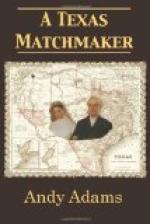Towards the close of March a number of showers fell, and we had a week of damp, cloudy weather. This was unfortunate, as it called nearly every man from the horse breaking to ride the range and look after the young calves. One of the worst enemies of a newly born calf is screw worms, which flourish in wet weather, and prove fatal unless removed; for no young calf withstands the pest over a few days. Clear dry weather was the best preventive against screw worms, but until the present damp spell abated every man in the ranch was in the saddle from sunrise to sunset.
In the midst of this emergency work a beef buyer by the name of Wayne Orahood reached the ranch. He was representing the lessees of a steamship company plying between New Orleans and Texas coast points. The merchant at the ferry had advised Orahood to visit Las Palomas, but on his arrival about noon there was not a white man on the ranch to show him the cattle. I knew the anxiety of my employer to dispose of his matured beeves, and as the buyer was impatient there was nothing to do but get up horses and ride the range with him. Miss Jean was anxious to have the stock shown, and in spite of my lameness I ordered saddle horses for both of us. Unable to wear a boot and still hobbling on crutches, I managed to Indian mount an old horse, my left foot still too inflamed to rest in the stirrup. From the ranch we rode for the encinal ridges and sandy lands to the southeast, where the fallow-weed still throve in rank profusion, and where our heaviest steers were liable to range. By riding far from the watering points we encountered the older cattle, and within an hour after leaving the ranch I was showing some of the largest beeves on Las Palomas.
How that beef buyer did ride! Scarcely giving the cattle a passing look, he kept me leading the way from place to place where our salable stock was to be encountered. Avoiding the ranchitos and wells, where the cows and younger cattle were to be found, we circled the extreme outskirts of our range, only occasionally halting, and then but for a single glance over some prime beeves. We turned westward from the encinal at a gallop, passing about midway between Santa Maria and the home ranch. Thence we pushed on for the hills around the head of the Ganso. Not once in the entire ride did we encounter any one but a Mexican vaquero, and there was no relief for my foot in meeting him! Several times I had an inclination to ask Mr. Orahood to remember my sore ankle, and on striking the broken country I suggested we ride slower, as many of our oldest beeves ranged through these hills. This suggestion enabled me to ease up and to show our best cattle to advantage until the sun set. We were then twenty-five miles from the ranch. But neither distance nor approaching darkness checked Wayne Orahood’s enthusiasm. A dozen times he remarked, “We’ll look at a few more cattle, son, and then ride in home.” We did finally turn homeward, and at a leisurely gait, but not until it was too dark to see cattle, and it was several hours after darkness when we sighted the lamps at headquarters, and finished the last lap in our afternoon’s sixty-mile ride.




